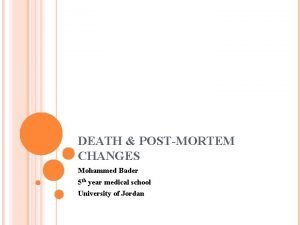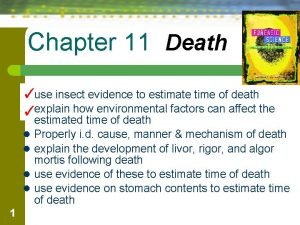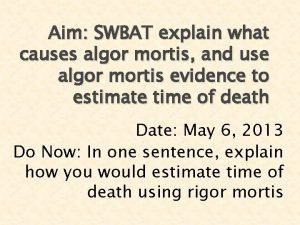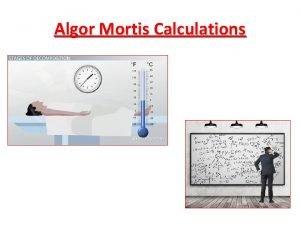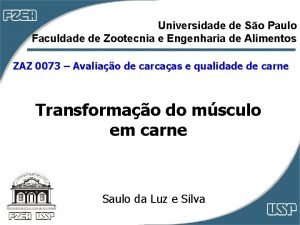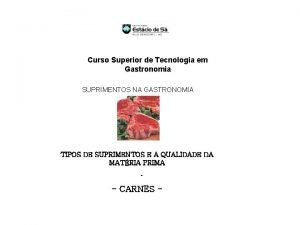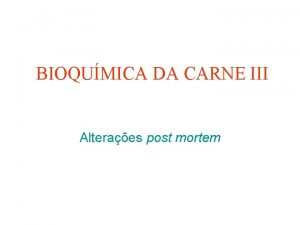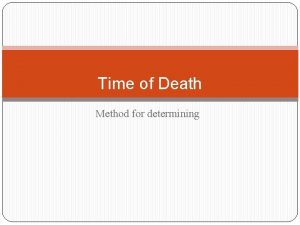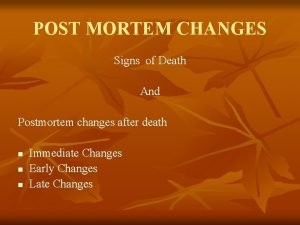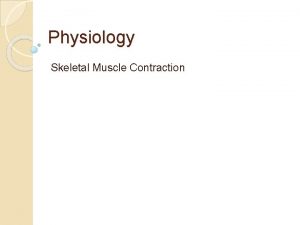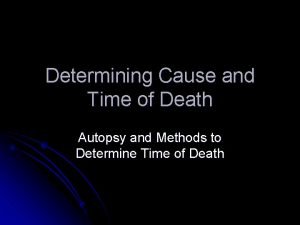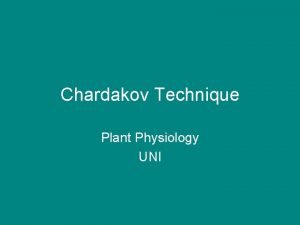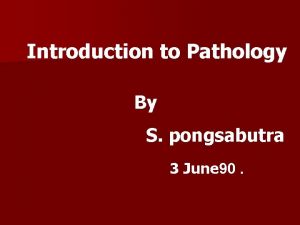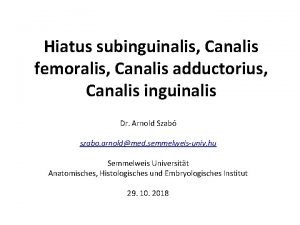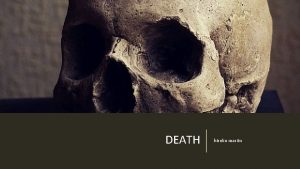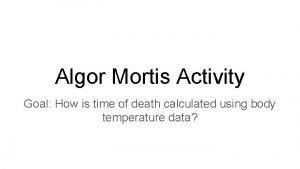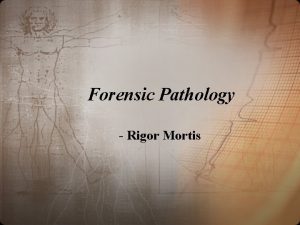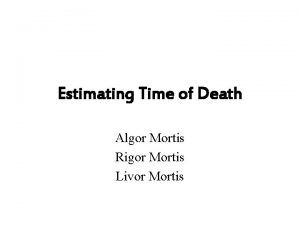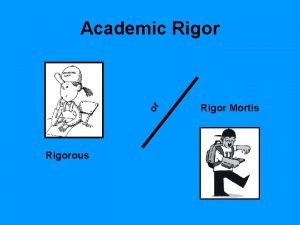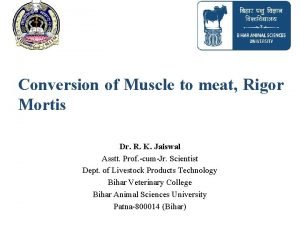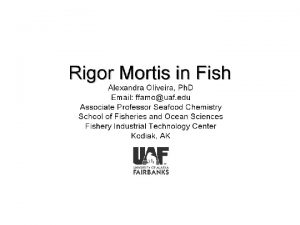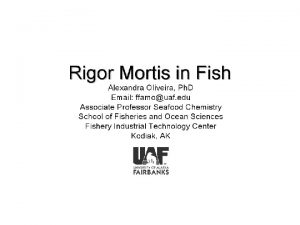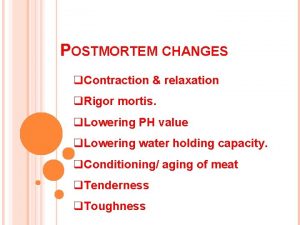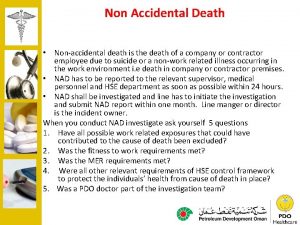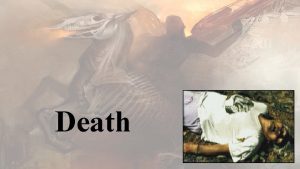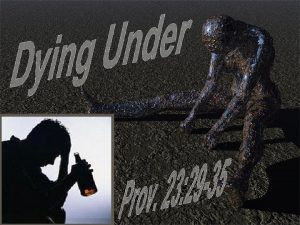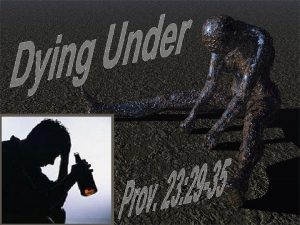Time of Death Method for determining Rigor Mortis
































- Slides: 32

Time of Death Method for determining

Rigor Mortis “death stiffness” results in the shortening of muscle tissue and the stiffening of body parts in the position at death (occurs within the first 24 hrs. and disappears within 36 hrs. ). Starts in the head and works its way down to the legs. At 12 hours the body is most rigid. Skeletal muscles cannot relax. When you are alive, muscles release Calcium to contract. This Calcium is removed from the cells, which requires energy. In death, there is no energy, thus Calcium is not removed and the muscles remain contracted. After 12 hours, the muscle cells begin to dissolve by autolysis

Factors that affect rate of rigor mortis Environmental temperature – cooler, slower A person’s weight – Body fat stores extra oxygen (therefore more energy is available after death) Type of clothing – Clothing keeps the body warm Illness – fever vs. hypothermia Level of activity before death – high activity, faster Sun exposure – Direct sunlight, warmer, faster

Livor Mortis “Death Color” results in the settling of blood in areas of the body closest to the ground (begins within 2 hours after death and continues up to 12 hrs. ). Red Blood cells break down, spilling out hemoglobin. This turns purple, outside of the cell. This is visible where the blood pools. “Lividity” – pooling of the blood. Discoloration is permanent after 8 hours. Environmental factors affect the rate

Lividity Pooling of blood Can provide time of death Can reveal the position of a corpse during the first 8 hours Face down? On back? Standing? Reveal if the body has been moved

Algor Mortis “Death Heat” results in the loss of heat by a body (a general rule, beginning about an hour after death, the body loses heat by 1 to 1 1/2 degrees Fahrenheit per hour until the body reaches the environmental temperature).

Predictable Pattern of Decay • Body is intact, decay inside body • Lasts until body becomes bloated Fresh • Blow flies (Calliphoridae) and Fresh flies (Sarcophagidae are among first to arrive • Body becomes visibly inflated due to the production of gases from bacteria that begin to Bloated putrefy the body • House flies (Muscidae) now join other flies • Skin breaks and body deflates • Smells BAD Decay • Most maggots have finished development

Pictures of Process Fresh Bloat Decay

Butyric Fermentation All the remaining flesh is removed over this period and the body dries out. It has a cheesy smell, caused by butyric acid, and this smell attracts a new suite of corpse organisms. . Insect activity The reduction in soft food makes the body less palatable to the mouth-hooks of maggots, and more suitable for the chewing mouthparts of beetles.

Newton’s Law of Cooling describes the cooling of a warmer object to the cooler temperature of the Environment T(t)=Te+(To-Te)e-kt To is initial temperature of object (98. 6 degrees F) Te is constant temperature of environment T(t) is the temperature of the object at any time t (from graph) k is a constant

Graph of Newton’s Law of Cooling

Anthropology Forensic Anthropology is concerned primarily with the identification and examination of human skeletal remains. Radiologic dating uses carbon dating techniques to determine approximate age of bones

Carbon Dating Carbon-14 is an isotope of carbon Isotopes have the same number of protons, different numbers of neutrons Carbon-14 dating can be used to find the ages of once-living things because all organism absorb Carbon-14 when they are alive Once an organism dies, its body begins to lose Carbon-14 at a fixed rate. Scientists can measure the amount of Carbon 14 remaining in a skeleton to determine the date the person died.

Half -life -- the amount of time for 1/2 of the sample to decay

Entomology Forensic Entomology is the study of insects and their relation to a criminal investigation, commonly used to estimate the time of death.

Of Maggots and Murder Flies are among first to colonize carcass Usually arrive within 10 minutes As carcass decays, conditions change Drier Temperature drops Tissues break down

Order of Insect Appearance Blowflies Other flies Tiny Wasps (lay eggs on maggots)…live as parasites in maggots Beetles and Mites (when body is drier)

Blowfly Development Egg (8 hours) Larva 1 (aka “instar 1”) Larva 2 (aka “instar 2”) Larva 3 (aka “instar” 3) Pre-pupa Early and late pupa Adult Changes in size, color, mobility and external physical changes enable a scientist to determine when the blowflies arrived at the body.

Orifices and Openings When flies arrive, search out natural orifices (mouth, ears, nose) If larvae are found in other places (like chest cavity), this indicates possible stab wounds or openings in that region

Additional Factors Drugs present at the time of death can affect developmental rate of the maggots Cocaine speeds up development Arsenic slows development Insects feed on toxins (removing them from body) making it difficult to test for them

Stomach Contents The composition of a victim’s last meal can often provide details concerning TOD. Used for additional sources of information as well. Prominent case study includes Nicole Brown Simpson

Presence of Macromolecules can be detected Lipids Proteins Simple carbohydrates Complex carbohydrates

Lipids Function as long-term energy storage Important component of the cell membrane Consist of glycerol and fatty acid “tails” “Tails” are long chains of carbon and hydrogen and contribute to the non-polar behavior of fats Sudan Red is a fat-soluble dye that stains lipids red. Using Sudan red can show the amount and location of lipids

Both test tubes contain lipids

Proteins Complex specialized molecules composed of carbon, oxygen, hydrogen, nitrogen, and sometimes sulfer Proteins have many important roles in organisms. Structural proteins such as collagen or elastin provide support Regulatory proteins such as enzymes control cell processes Buiret solution is a blue liquid that changes to purple in the presence of short chains of polypeptides The copper atom of the biuret solution reacts with the peptide bonds to cause the color change.

The purple one contains protein

Monosaccharides and Disaccharides Monosaccharides are simple sugars such as glucose and fructose that function as energy source in cells during cellular respiration Disaccharides are composed of two monosaccharides together Sucrose (table sugar) is an example of a disaccharide

Other Carbohydrates -- starch Lugol’s solution -- an iodine solution used to detect starch A dark blue color indicates starch Large number of simple sugar molecules joined by glyosidic bonds Produced by all plants Consumed by humans

Lipid Test:

Protein Test

Glucose Test

Starch Test
 Mortisn
Mortisn Cadaveric spasm
Cadaveric spasm Cadaveric spasm and rigor mortis difference
Cadaveric spasm and rigor mortis difference Site:slidetodoc.com
Site:slidetodoc.com Determining time of death worksheet
Determining time of death worksheet Cadaveric spasm and rigor mortis difference
Cadaveric spasm and rigor mortis difference Foamy liver is seen in putrefaction
Foamy liver is seen in putrefaction Casper's dictum
Casper's dictum Rigor mortis eyes
Rigor mortis eyes Algor mortis formula
Algor mortis formula Resolução do rigor mortis
Resolução do rigor mortis Maciez da carne bovina
Maciez da carne bovina Resolução do rigor mortis
Resolução do rigor mortis Rigor mortis
Rigor mortis Diaphanous test
Diaphanous test The phenomenon of rigor mortis is a direct result of
The phenomenon of rigor mortis is a direct result of Body decomposition
Body decomposition Methods for determining time of death
Methods for determining time of death Write about the hittorf rule
Write about the hittorf rule Chardakov method principle
Chardakov method principle Trimalawn
Trimalawn Difference between somatic and cellular death
Difference between somatic and cellular death Credo certe ne cras
Credo certe ne cras Rivor mortis
Rivor mortis Algor mortis chart
Algor mortis chart Mortis
Mortis Hypo stasis
Hypo stasis Mortis
Mortis Time since death
Time since death Anulus inguinalis profunda
Anulus inguinalis profunda Algor mortis
Algor mortis Mortis
Mortis Casus mortis
Casus mortis


